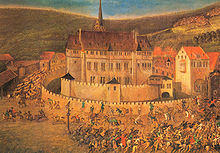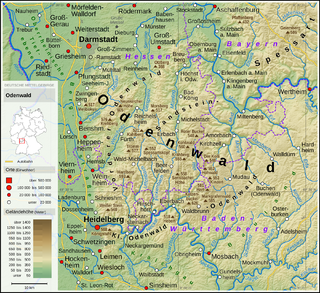
The Odenwald is a low mountain range in the German states of Hesse, Bavaria and Baden-Württemberg.
The Odenwaldkreis is a Kreis (district) in the south of Hesse, Germany. Neighboring districts are Darmstadt-Dieburg, Miltenberg, Neckar-Odenwald-Kreis, Rhein-Neckar-Kreis and Kreis Bergstraße. Odenwaldkreis belongs to the Rhine Neckar Area.
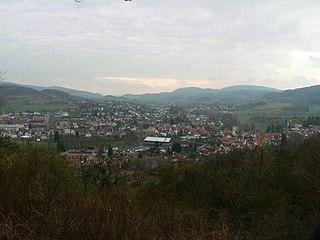
Reichelsheim (Odenwald) is a municipality in the Odenwaldkreis (district) in Hesse, Germany.

Zwingenberg lies in the Bergstraße district in southern Hessen, Germany, south of Frankfurt and Darmstadt, and with the granting of town rights coming in 1274 it is the oldest town on the Hessen Bergstraße.

Groß-Umstadt is a town in the district of Darmstadt-Dieburg in the Bundesland of Hesse in Germany. It is near Darmstadt and Frankfurt, in the southeastern part of the Rhine-Main Metropolitan Region, just north of the Odenwald mountain range.

Michelstadt in the Odenwald is a town in the Odenwaldkreis (district) in southern Hesse, Germany between Darmstadt and Heidelberg. It has a population of 28,629 people.

Erbach is a town and the district seat of the Odenwaldkreis (district) in Hesse, Germany. It has a population of around 13,000.

Balkhausen is a village of 693 inhabitants forming part of the municipality Seeheim-Jugenheim, Darmstadt-Dieburg district in Hesse, Germany.
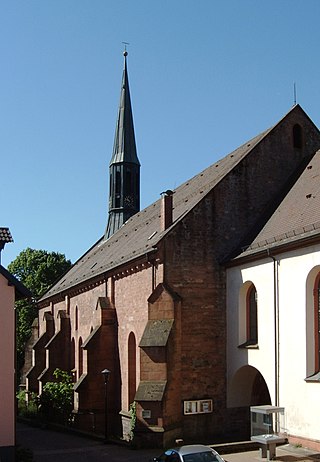
Schönau Abbey in Schönau in the Odenwald, in the Rhein-Neckar-Kreis in Baden-Württemberg, was a Cistercian monastery founded in 1142 from Eberbach Abbey. The present settlement of Schönau grew up round the monastery.
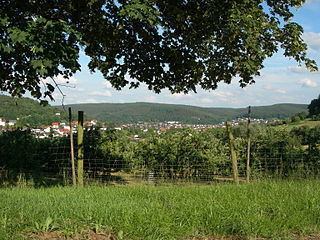
Höchst im Odenwald is a municipality in the Odenwaldkreis (district) in Hesse, Germany.
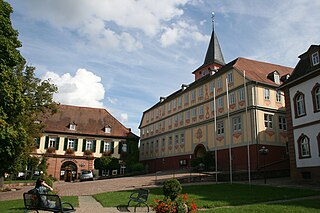
Bad König is a town and resort (Kurort) in the central Odenwald in the Odenwaldkreis (district) in Hesse, Germany, 29 km southeast of Darmstadt.
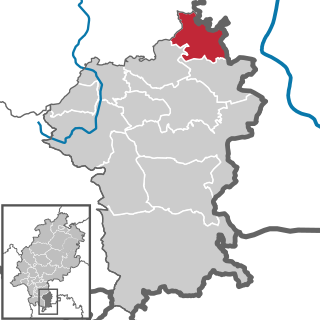
Breuberg is a town in the Odenwaldkreis district of Hesse, Germany. It is 28 km east of Darmstadt and 20 km southwest of Aschaffenburg.
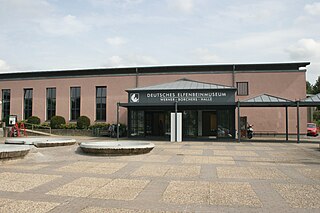
The German Ivory Museum Erbach is a museum in Erbach im Odenwald, Germany. It was founded in 1966, but the collection was started by Count Francis I in the late 18th century. The city of Erbach then developed to become one of the centres for ivory carving.
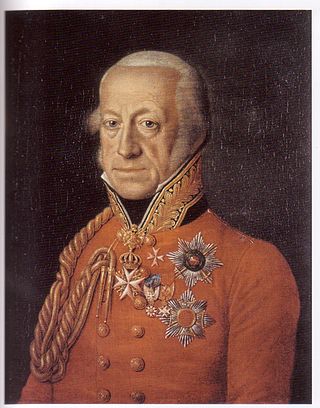
Franz Graf zu Erbach-Erbach was a German nobleman and art collector.

Schloss Heiligenberg is a castle to the east of Jugenheim, part of Seeheim-Jugenheim, about 12 kilometres to the south of Darmstadt, Germany. It is built on the Heiligenberg, with panoramic views of the Rhineland as far as the Palatinate. It is now the headquarters of the Amt für Lehrerbildung, though its 'Gartensaal' is occasionally used for concerts and art exhibitions.

Otzberg Castle in the German state of Hesse is a medieval castle on the summit of the Otzberg in the Odenwald forest at a height of 367 m above NN. On its northern slopes is the village of Hering, which grew out of the lower ward or castellan's settlement. The history of castle and village is therefore closely interwoven.
George Albert I, Count of Erbach-Schönberg, was a German prince member of the House of Erbach and ruler over Schönberg, Seeheim, Reichenberg, Fürstenau and since 1643 over all the Erbach family lands.

Bad Homburg Castle or Homburg Palace is a castle and palace in the German city of Bad Homburg vor der Höhe. Originally the residence of the Landgraves of Hesse-Homburg, it was first built in the 12th century.
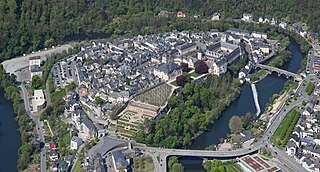
Schloss Weilburg is a Baroque schloss in Weilburg, Hesse, Germany. It is located on a spur above the river Lahn and occupies about half of the area of the Old Town of Weilburg. It contains the Hochschloss, built between 1530 and 1572, which is one of the best-preserved Renaissance palaces in Hesse. In the 1700s, the palace was expanded by John Ernst, Count of Nassau-Weilburg, and his builder, Julius Ludwig Rothweil. The buildings and gardens now belong to the Verwaltung der Staatlichen Schlösser und Gärten Hessen, and they can be visited as a museum on guided tours. Parts of the palace are venues for the music festival Weilburger Schlosskonzerte, which is named after the palace.
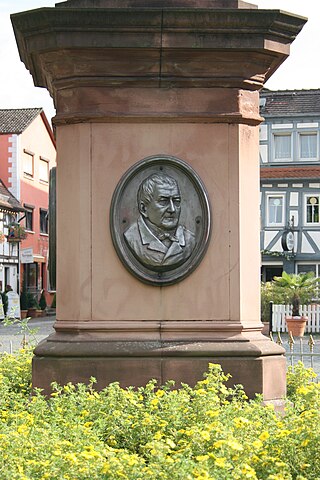
Christian Wilhelm Karl Kehrer of Erbach was a German hunting and animal painter, court painter and archivist.

